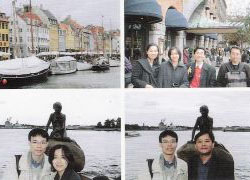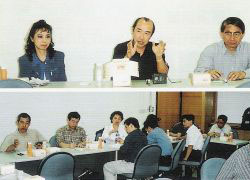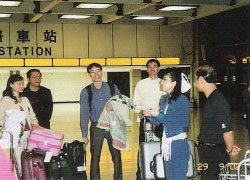Archilife Delegation for SB2002 International Conference(2) (Part: 4)
|
在用過午餐後,考察團員再也難掩滿腹的思鄉愁緒,個個歸心似箭,整裝準備踏上歸途。因為班機安排分批以策安全的緣故,年輕的考察團員還有時間進行半日之哥本哈根市區巡覽,而團長及主持人們則先行趕往機場。在黃晉英秘書長的殷切叮嚀與重點任務提示下,考察團員就此分道而行,活力十足的年輕團員們興緻勃勃地出發,陸續參觀丹麥港、皇宮、小美人魚雕像、噴水池與各個廣場等,並看到全世界第一座遊樂場。在興高采烈地與安徒生雕像合影紀念後,最後也依依不捨地踏上回家的旅途。  After lunch, we could not hide our nostalgic emotions anymore, and everyone just wanted to go home immediately. So we packed up everything to go home. For safety, we took different flights, and younger delegates still had time for a half-day tour of Copenhagen, while Secretary General Huang Chin-ying and principal investigators were headed to the airport first. After the thoughtful reminding and duty assignment of Secretary General Huang Chin-ying, we separated there. The energetic delegates visited the Denmark Harbor, Royal Palace, little mermaid statue, fountain and various squares, and even the world's first amusement park. After happily taking a picture with the statue of Hans Christian Andersen, they all started on the way home, though sad. After lunch, we could not hide our nostalgic emotions anymore, and everyone just wanted to go home immediately. So we packed up everything to go home. For safety, we took different flights, and younger delegates still had time for a half-day tour of Copenhagen, while Secretary General Huang Chin-ying and principal investigators were headed to the airport first. After the thoughtful reminding and duty assignment of Secretary General Huang Chin-ying, we separated there. The energetic delegates visited the Denmark Harbor, Royal Palace, little mermaid statue, fountain and various squares, and even the world's first amusement park. After happily taking a picture with the statue of Hans Christian Andersen, they all started on the way home, though sad. 經過漫長的飛行與轉機,由團長為首的部分團員率先抵達桃園中正機場。林俊興董事長等人早已在機場等候多時,迎接考察團員的凱旋歸來。求好心切的林俊興董事長特別在機場闢室召開心得分享會議,除了再次表達感謝考察團員的辛勞與付出外,也順道了解考察團員帶回來的第一手資訊。 經過漫長的飛行與轉機,由團長為首的部分團員率先抵達桃園中正機場。林俊興董事長等人早已在機場等候多時,迎接考察團員的凱旋歸來。求好心切的林俊興董事長特別在機場闢室召開心得分享會議,除了再次表達感謝考察團員的辛勞與付出外,也順道了解考察團員帶回來的第一手資訊。After the long flight and transit, Secretary General Huang Chin-ying and some delegates arrived at Taoyuan International Airport first. President Lin Chun-shin and others had been there waiting for the return of the delegation. A perfectionist, President Lin Chun-shin immediately held a sharing meeting with them at the airport. Besides expressing his gratitude for the efforts and devotions of delegates, President Lin Chun-shin wanted to get the first-hand information of the trip.  接著由團員們依序發表此行之收穫與感想。首先,江哲銘教授在稱許9月22日國際交流晚宴與9月25日專題演講成功之餘,也不忘提醒祐生必須為在東京舉辦之SB2005預做準備以及SB雜誌是一很好的交流平台;喻肇青副教授建議祐生可設置一個英文網站,並請求政府方面的配合;蘇慶華教授闡析此次國際研討會內容多偏向政策與評估指標,但仍欠缺如祐生一般有全方位整合的研究團隊;呂麗絲小姐除了轉達國外團隊對祐生之諸多褒獎外,也提出研討會的內涵隱含永續建築政策、技術與教育的挑戰。 接著由團員們依序發表此行之收穫與感想。首先,江哲銘教授在稱許9月22日國際交流晚宴與9月25日專題演講成功之餘,也不忘提醒祐生必須為在東京舉辦之SB2005預做準備以及SB雜誌是一很好的交流平台;喻肇青副教授建議祐生可設置一個英文網站,並請求政府方面的配合;蘇慶華教授闡析此次國際研討會內容多偏向政策與評估指標,但仍欠缺如祐生一般有全方位整合的研究團隊;呂麗絲小姐除了轉達國外團隊對祐生之諸多褒獎外,也提出研討會的內涵隱含永續建築政策、技術與教育的挑戰。Then, delegates shared their gains and opinions from the trip one after another. First, beside approving the success of the international exchange banquet on September 22 and the keynote speech on September 25, Professor Chiang Che-ming reminded us to get prepared for the SB2005 Tokyo and that SB Magazine was an excellent exchange platform. Associate Professor Yu Chao-ching recommended that we set up an English website and requested government cooperation. Professor Su Ching-hua explained that policy and assessment indicator were the foci of the SB2002 Oslo, and it lacked an integrated research team like us. In addition to reporting the commendations from overseas teams, Miss Wu Lu Lee-shih pointed that the challenges in SB policies, technologies and education were hidden behind the seminar. 蘇慧貞教授則歸納西班牙團隊之所以得獎的緣由,為全國由上到下的動能與決心,從無到有的呈現,令評審者感動;李彥頤先生對國外建築師的看法提出他的觀察;林慶元教授說明主要回收材料多為磚、石與木,以及以木材做為環境調整用料等看法;陳泰安先生有感而發永續建築的系統多出自西方觀點,而提出永續的概念應發展區域特性,如溫熱、颱風與社會差異等;周伯丞先生指出祐生在建築循環的成果較具代表性,但差別在於國外已有深刻的體認並有意願將之付諸實行,即進駐到實驗建物中;蔡坤憲先生表示國外永續建築未考慮、熱、溫帶環境的差別,如公共衛生傳染病;林芳銘先生說明永續不僅須與政策教育結合,更須與商業結合,若加以推廣會更快。郭肇立教授闡述許多舊房子再利用的國外案例,建議可於SB2005提出本土的歷史建築再利用案例;李宏謨教授直陳永續建築案例中有生物多樣性、廚餘堆肥、乾式馬桶等概念,經營則應透過官方與非官方的共同努力;鍾基強教授指出永續建築已經有越來越多具工程背景的人投入,還有訂定永續建築評估指標等須再接再厲的目標;劉定衢先生分析現今祐生將不單面對來自中共內部的壓力,也包括中共參與的國際組織的壓力;李君如小姐提出永續建築中包含有網路連結、技術導向與案例研究等三大方向;鍾松晉先生說明永續的概念須推廣至台灣各地,而非侷限在室內的討論;王文安先生指出SB的案例有大幅擴增的現象,挪威案例擴展的效率也值得我們學習;高傳棋先生建議永續建築的推動可借力使力,藉由小規模的村落力量來推動,因為若由社會與社區出發,不易感覺到人的互動。接著,黃晉英秘書長除了再次肯定大家的努力,對於此行深入之知己知彼考察後,發現祐生的研究層級比參訪的國外案例都來得高,也感到相當慶幸,她亦不忘嘉獎祐生團員們的潛力,不管是國際禮儀或是以英語應對都展現出該有的水準。使祐生的國際化有了很好的開端,圓滿達成此行的任務。 Professor Su Huey-jen concluded the reasons why the Spanish team won the award: the whole country was courageous and determined and turned nothing into something. This was what impressed the jury. Mr. Li Yen-yi expressed his view on the opinions of foreign architects. Professor Lin Ching-yuan expressed that bricks, stones and wood were the main recyclable materials; and the idea of wood as an environmental adjustment material. Out of emotions, Mr. Chen Tai-an claimed that the SB system was introduced from the Western point of view, and recommended that sustainable development should correspond to regional characteristics, such as climate, typhoon pattern, and social differences. Mr. Chou Po-cheng pointed out that the ARF was quite outstanding in the area of building cycle, but it has been well recognized by foreign countries which would put it to practice, i.e. inhabiting in experimental buildings. Mr. Tsai Kun-hsien indicated that the differences between the temperate and tropical areas were not considered in SB proposed by foreign countries, such as public health and infectious diseases. Mr. Lin Fang-ming suggested that besides policies and education, sustainability should be combined with business, and it would be faster in the presence of promotion. Professor Kuo Chao-lee mentioned many examples concerning the reuse of old buildings overseas, and suggested that we may introduce a historical building reuse project at SB2005. Professor Lee Horng-mo directly pointed out that SB cases contained the biodiversity, kitchen waste compost and dry toilet concepts, and SB should be operated by the concerted effort of government and non-government organizations. Professor Chung Kee-chiang pointed out that more and more people with true engineering background were joining the SB area, and greater efforts were needed to establish the SB assessment indicators. Mr. Liu Ding-chyu maintained that the ARF not only needs to face the pressure from Communist China, but also the pressure from international organizations in which it participates in. Miss Li Chun-ju proposed that SB should include network connection, technical orientation, and case study. Mr. Chung Sung-chin suggested that the sustainability concept should be spread to all parts of Taiwan, instead of indoor discussions. Mr. Wang Wen-an pointed out that there was a large increase in SB cases, and we should learn from the expansion efficiency of Norway. Mr. Gao Chuan-chi suggested that we could promote SB with the power of others; i.e. we may start from small villages, because we may not feel human interactions from the society and community. Then, Secretary General Huang Chin-ying approved the hard work and devotion of everybody again and felt very happy to discover that the level of the ARF team was much higher than the team from other countries from this trip where we understood the strength of ourselves and others. She also praised the potentials of ARF members. In either international etiquette or English conversion, they did well and appropriately. This has brought a good start to ARF's internationalization. The mission of this trip was accomplished smoothly. 最後林俊興董事長也做出結論:「有關 GB 的基礎研究已趨向成熟,但因找不到出路,而開始走向 SB 這一路徑。然而,因為對 "S" 沒有概念,所以變成各說各話的局面,這其中的關鍵就在於缺少共生化。以往所有的人類文明就是不斷地向大自然需索,因而形成不斷擴張的結果。欲使擴張收斂,甚至趨向收縮,就必須採取共生化,否則無法成功。」 Lastly, President Lin Chun-shin drew the conclusions, "Though the basic GB research is mature, we started with SB because we haven't found the way out. However, as they have no idea about "S" , it turns out to be different people have a different story, and they do not realize that symbiosis is the key. Human civilizations used to take from nature, and incessant expansion was the consequence. If we want to control and even reduce expansion, we must practice symbiosis; otherwise, we'll fail."  會議結束,林俊興董事長與黃晉英秘書長一一目送團員離去,接著繼續留在機場迎接其他團員的歸來。在他們的左顧右盼之下,團員們終於在接近子夜時分安抵國門,平安且順利地完成本次考察之旅。 會議結束,林俊興董事長與黃晉英秘書長一一目送團員離去,接著繼續留在機場迎接其他團員的歸來。在他們的左顧右盼之下,團員們終於在接近子夜時分安抵國門,平安且順利地完成本次考察之旅。After the meeting was adjourned, President Lin Chun-shin and Secretary General Huang Chin-ying saw them off. Then, they continued to wait for other delegates at the airport. After a long expectation, other delegates returned to Taiwan at midnight, and the investigation trip ended smoothly. 此次祐生2002年永續建築國際會議考察團初試啼聲,成功地站上國際舞台,打開國際視野,並令國外學者留下深刻的印象,成果豐碩。但祐生並不以此為限,相反地,為了人類的永續,祐生將更加努力與奮鬥不懈驗證「共生圈一號」之可行性,讓世人共享祐生辛勤耕耘的果實。 Though the SB2002 Oslo was the first international event in which ARF participated, it successfully stood firm on the international stage, broadened its international view, and impressed foreign scholars. The results were fruitful. However, instead of being self-content, we shall continue to verify the feasibility of the Symbiosphere 1 Center with all our might and share our achievements with the world for the sustainability of mankind. |

